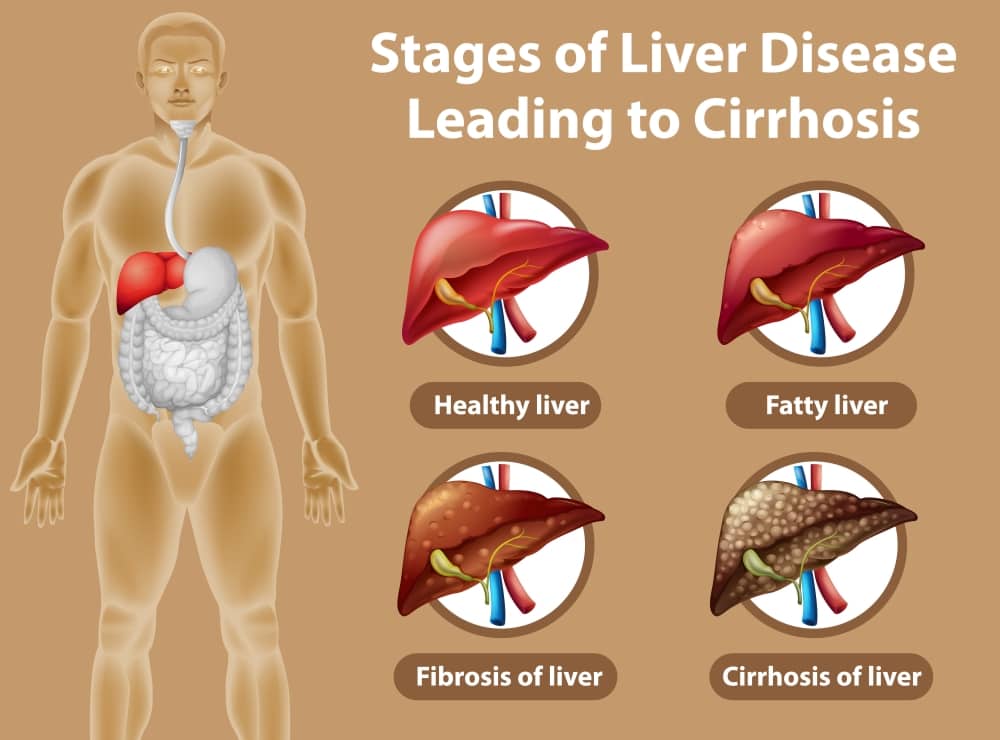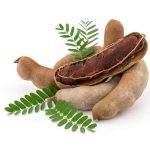ABSTRACT
Liver Cirrhosis is the scarring and fibrosis of the Liver and it is the last stage of liver disease. The liver is located in the upper right portion of the abdominal cavity below the diaphragm. It is the large organ in the abdomen which is spongy, wedge-shaped and reddish brown in colour. The liver has many jobs which are helpful in clearing toxins and regulating the amount of blood in the body. The liver has two main parts- the larger right lobe and the smaller left lobe which contain various blood vessels, which remove toxins and waste and eventually leave the body through urine and faeces. When the liver breaks down its harmful substances the by-products are excreted into bile and blood which enter the intestines and leave the body through faeces. The liver weighs between 3-3.5 pounds. Further, we will discuss the causes, symptoms and ayurvedic aspects in detail.
INTRODUCTION
Liver Cirrhosis/Hepatic Cirrhosis is an end-stage liver disease which impairs the functions of the liver and forms a scar of the tissues which is known as Fibrosis which is caused by liver disease. It permanently damages the liver so that the liver doesn’t work properly which leads to the death of cells and inflammation. The scar tissue blocks the flow of blood and slows down the ability of the liver to nutrients and hormones. Reduces the production of proteins which is made by the liver. Late Stage cirrhosis is life-threatening.
CAUSES OF LIVER CIRRHOSIS
The Most Common Cause of Liver Cirrhosis is
- Alcohol-related liver disorder
- Chronic Viral Infections (Hepatitis B and Hepatitis C)
- Fatty Liver is associated with Diabetes and Obesity.
- Inherited Diseases- Wilson Disease, Cystic fibrosis, Hemochromatosis
- Autoimmune Hepatitis
- Damage to the Bile Ducts
- Medications include Acetaminophen and other antidepressants.
- Biliary atresia
- Amyloidosis- abnormal deposit of protein which disrupts the normal function of the liver.
SYMPTOMS
- Decreased appetite
- Nausea
- Unexpected weight loss
- Swollen and enlarged Veins
- Yellowish discolouration of the eyes
- Itchy skin
- Abdominal swelling with swelling in the legs
- Redness in the palms of the hand
- In Men- Loss of sex drive and gynecomastia
- In Women- Promotes Menopause
- Confusion, memory loss and various personality changes
STAGES OF LIVER CIRRHOSIS
There are two technical Stages- Compensated Cirrhosis and Decompensated Cirrhosis
- Compensated Cirrhosis- It is asymptomatic and shows scarring on the liver.
- Decompensated Cirrhosis- This stage shows symptoms like jaundice and ascites. It is a serious stage. It can show various signs of these conditions-
- Jaundice- The liver cannot get rid of the bilirubin and this waste product gets accumulated in the eyes and skin.
- Ascites– Fluids get filled in the belly.
- Bleeding Varices– The veins get enlarged, which results in black tarry stools.
- Hepatic encephalopathy– Toxins get accumulated in the brain and cause trouble in daily activities such as driving and writing.
DIAGNOSIS
- Liver Function Test
- Alpha Fetoprotein
- Upper Endoscopy
- Ultrasound of liver
- MRI (Magnetic resonance imaging)
- CT Scan (Computed technique)
- Liver Biopsy
TREATMENT
- Medications such as beta blockers and nitrates
- Various Lifestyle changes
- Surgery
GRADING
The severity of the cirrhosis is classified with the Child-Pugh Score which is known as Child-Pugh-Turcotte Score. The patient is classified into A, B and C classes.
- Child-Pugh (Class A)- 5-6 Points, which shows good liver function
- Child-Pugh (Class B)- 7-9 Points, which shows moderately impaired functions of the liver
- Child-Pugh (Class C)- 10-15 Points, which shows advanced dysfunction of the liver.
COMPLICATIONS OF LIVER CIRRHOSIS
- Bacterial infections
- Decreased clotting proteins
- Kidney Failure
- Malnutrition
- Hepatic Encephalopathy
- GallStones
- Splenomegaly
AYURVEDIC ASPECT
Ayurveda treats the disease from its root cause and it is a natural system which originated in India. Ayurvedic treatment for liver cirrhosis is helpful in detoxifying the liver and reducing inflammation and thus improving the functions of the liver. The liver is known as Yakrit (Yakrit means liver and Vikara means derangement) in Ayurveda which is Pitta predominant of the liver. Most liver disorders are aggravated by Pitta doshas, the excessive production of Bile causes blockages in the flow of bile which indicates a high level of Pitta doshas, further affecting the agni and enzyme activities. Aggravation of the doshas leads to unhealthy functioning of the liver which also imbalances the other Doshs (Vata and Kapha doshas). Rasa and Rakta Dhatu also get intoxicated which further weakens the other Dhatus in the body. All functions of the Pitta doshas get affected which include Digestion of food, Appetite and Complexion of the skin.
Shlok charak chikitsa 16/3
Kumbha Kamala is the classical description for liver cirrhosis in ayurveda, it is the advanced stage of Kosthasrita Kamala. When left untreated it becomes deep-seated (kharibhuta) which becomes very difficult to cure. This is known as Kumbhkamala. It is Krichasadhya Vyadhi.
DOSHAS INVOLVED IN LIVER CIRRHOSIS
By looking at the symptoms we can have a look at doshas which are linked in liver cirrhosis, here are some symptoms which are present in the patient with liver cirrhosis-
- Loss of Appetite- Low pitta doshas and high kapha
- Fatigue- Aggravated Kapha doshas
- Easily bleeding and bruising- Aggravated Pitta doshas
- Nausea- Aggravated Kapha doshas
- Itchy Skin- Aggravated Kapha and Pitta doshas
- Oedema- Swelling (Aggravated Kapha doshas)
- Jaundice- Aggravated Pitta doshas
- Spider Like vessels on the body- Aggravated Pitta doshas
- Hepatic Encephalitis- Aggravated Vata doshas
So in liver cirrhosis, The origin is Pitta doshas which get stuck with Kapha doshas and Vata doshas.
CHIKITSA OF LIVER CIRRHOSIS
The main goal to treat liver cirrhosis is to pacify the doshas and to cleanse the liver to detoxify the body and support the liver with natural pure herbs and nutrients. Along with herbs, Ayurveda recommends various lifestyle changes which support the liver to promote its healing. Digestion also plays an important role in maintaining the proper health of the liver.
- The Agneya Chikitsa and Rasayan Chikitsa promote the functioning of the liver and reduce the scarring of the cells and tissues.
- Deepana (carminatives)
- Pachana (digestives)
- Mashodhaka (laxative)
- Pittavirechaka herbs (cholagogues)
Panchkarma Treatment (Vamana and Virechana) is helpful in expelling out the aggravated Kapha and Pitta doshas, removes toxins from the body and releases stress and promotes blood circulation.
Follow Yoga and various dietary modifications which reduces the chances of Liver Cirrhosis.
HERBS USEFUL IN THE TREATMENT OF LIVER CIRRHOSIS
There are many herbs which are useful in the treatment of liver cirrhosis which are helpful in this disease without any side effects. Further we are going to discuss the herbs which are helpful in the treatment of Liver Cirrhosis-
1. SHARPUNKHA
Sharpunkha (Tephrosia purpurea) is a perennial herb which has great medicinal properties in the treatment of liver cirrhosis and splenomegaly. It mainly grows in wasteland and cultivated as a manual crop. Herb is 50 cm tall with a woody stem and leaves are imparipinnate. Balances Vata and Kapha doshas in the body.
Benefits of Sharpunkha
- Helpful in detoxification of liver and in regeneration of new liver cells.
- Has kidney protective properties which removes toxins from the body.
- Has anti-inflammatory and analgesic properties which reduces body ache and fever.
- Resolves the digestive disorders and provides relief in heartburn.
2. BHRINGRAJ
Bhringraj (Eclipta alba) is commonly known as False daisy which acts as a Rasayan and balances the tridoshas of the body. It is a creeping herb about 3 metres in height which has a long stalk with white colour flowers. This plant is moisture loving and found in moist places throughout the world. It is native to South America and India, grows in paddy growing fields.
Benefits of Bhringraj
- Balances Pitta Doshas in the body
- Prevents premature hair greying and useful in providing strength to the roots of hair.
- Promotes overall health of liver and maintains the metabolism of liver
- Has rejuvenative properties and reduces the undigested food.
1. BHUMI AMLA
Bhumi Amla (Phyllanthus Niruri) is a miraculous herb in ayurveda which is a small plant that grows in the rainy season in the month of November and December. It has a very good effect on the liver as it is Tikta as Predominant. Tropical plants which grow at the height of 50-70 cm in height, the flowers are pale green in colour and bark is light green in colour.
Benefits of Bhumi Amla
- Effective in Anaemic Patients and in various bleeding disorders
- Beneficial in skin diseases
- Useful in anorexia and ion chronic respiratory disorders
- Has hepatoprotective and diuretic property
- Useful in cough and cold problem
- Protects the stomach lining against excessive acid
3. PUNARNAVA
Punarnava (Boerhavia diffusa) is an amazing herb in ayurveda which is effective in a large number of diseases. It is a perennial diffuse herb which has a horizontal stem that is purple in colour. Flowers are small in size and are red in colour. It is found throughout India and in various parts of Australia, Sri lanka and in Southern United Parts. Grows at an altitude of 2000 metres in the temperate region of the country.
Benefits of Punarnava
- Has antiviral and Antibacterial activity
- Has diuretic properties which removes the excess water from the body
- Rejuvenates the kidney cells
- Effective in Urinary tract infections
- Has hepatoprotective property which stimulate the secretion of bile to keep healthy liver
- Improves functions of liver
- Helpful in treating arthritis and provide relief in joint pain and inflammation of muscles.
4. KUTKI
Kutki (Picrorhiza kurroa) is an amazing herb which has a bitter taste, is a perennial herb which attains the height of 25-30 cm and has small flowers which are purple in colour. It is native to India which is mainly distributed in various parts of Asia and is well distributed in the Himalayas and in the region of nepal. Removes the impurities of blood and is good for all types of skin problems.
Benefits of Kutki
- Useful in the yellow pigmentation of skin and treats this disorder
- Pacify the vitiated Pitta doshas in the body.
- Stimulate the digestive fir and protects the abdomen from various harmful infections in the body
- Reduces stiffness of joints and relieves joint pain
- Removes the harmful toxins from liver and protect this organ
- Helpful in chronic constipation as it is purgative in nature.
5. ROHITAKA
Rohitaka (Tecoma undulata) is a medium sized tree which grows in the Himalayas belt of North and West India to a height of 6-10 metres. The flowers are yellow in colour and seen in the months of April and May. The leaves resemble the leaves of a pomegranate. Helpful in reducing the Vitiated Kapha and Pitta doshas.
Benefits of Rohitaka
- Useful in the treatment of liver and spleen disorders.
- Has anti-inflammatory property so useful in skin diseases
- Treats diabetes and jaundice
- Has antitussive property which clears the passage of airways in lungs
- Has antiviral property which is helpful in hepatitis
- Regenerates the live cells and provides relief in itchy skin, weight loss.
There are many more herbs which are useful in the treatment of liver cirrhosis from its root cause such as Gurmar, Yashtimadhu, Daruharidra, Kasni, Jhavuka, Himsra, Apamarg and many more without any side effects.
CONCLUSION
The liver is located in the upper right portion of the abdominal cavity below the diaphragm. It is the large organ in the abdomen which is spongy, wedge-shaped and reddish brown in colour. Liver Cirrhosis/Hepatic Cirrhosis is an end-stage liver disease which impairs the functions of the liver and forms a scar of the tissues which is known as Fibrosis which is caused by liver disease. The liver is known as Yakrit (Yakrit means liver and Vikara means derangement) in Ayurveda which is Pitta predominant of the liver, Kumbha Kamala is the classical description for liver cirrhosis in ayurveda, it is the advanced stage of Kosthasrita Kamala. Further we discussed ayurvedic herbs which are useful in the treatment of Liver Cirrhosis without any worries!
Author Bio
Dr. Vikram Chauhan (MD – Ayurveda) is the CEO and Founder of Planet Ayurveda Pvt. Ltd. He is Author of the Book “Ayurveda – God’s Manual For Healing”. He is an Ayurveda Expert Serving People worldwide through all the Possible Mediums, Operating from Main Branch in Mohali, India. With his Vast Experience in Herbs and their Applied Uses, he is successfully treating Numerous Patients suffering from Various Ailments with the help of Purest Herbal Supplements, Diet, and Lifestyle, according to the Principles of Ayurveda



